How To Create a Project Management Workflow in Seven Steps

Sorry, there were no results found for “”
Sorry, there were no results found for “”
Sorry, there were no results found for “”
If you’re a project manager managing multiple projects, you may worry that you are not entirely updated about each project’s progress.
These worries will haunt you even more if you manage large or complex projects where improper planning can result in poor output, extended deadlines, and overshooting budgets.
However, the solution to these challenges is creating a project management workflow. A project workflow gives you better visibility and control over every project’s tasks, resources, deliverables, and milestones.
It can help you track the progress of your projects and identify bottlenecks before they escalate.
In this blog, we’ll explore the what and why of project management workflows. We’ll also examine setting up a workflow to manage your projects, the project management tools to help you, and some best practices.
A project management workflow is a logical sequence of steps that outlines how a project should progress from start to finish. It includes definitive guidelines on project planning and execution and breaks down complex processes into manageable tasks.
Project management workflows clearly define everyone’s responsibilities, how to address escalations, and the tools to be used.
A project management workflow outlines a clear roadmap that tells teams how to execute projects successfully. They help:
Let’s see how project management differs from workflow management.
| Aspect | Project management | Workflow management |
| Definition | Project management encompasses overseeing all the steps from start to finish of a project | Workflow management outlines the sequence of steps required to complete a project efficiently |
| Key components | Initiation, planning, executing, monitoring, controlling, and closing | Define inputs, processes, and outputs expected from a project |
| Objective | Ensure timely delivery of projects while keeping sight of budget constraints, quality benchmarks, and project objectives | Improve productivity, enable collaboration, and increase operational efficiency by streamlining various processes |
This is the starting point of your project management workflow, where you list all the inputs required to complete your project. This includes resources, materials, and information needed to execute the project seamlessly. While defining the input, you will have to put together the following:
After understanding the inputs, outline the process and project execution steps. You must break the workflow into individual tasks and sequence them, giving all stakeholders a clear idea of their expectations. Define deadlines for each task and identify the dependencies in completing these tasks.
Next, map the process flow using a workflow diagram, show how workflow automation tasks are interconnected, and add key milestones and deliverables for all project phases.
The output is the final element of the workflow. It comprises the expected outcomes at the end of the workflow and showcases the tangible and intangible results of each task within the workflow.
The outputs in your workflow can include:
Pro tip 💡: Instead of creating a project management workflow from scratch, use pre-built project management workflow templates to map your business processes and visualize the key components of the process.
Workflows help manage projects well and within budgets and significantly impact business process management (BPM). BPM is an organization-wide activity that optimizes processes and workflows to improve business outcomes.
Here is why project management workflows are essential in BPM:
A workflow provides a standard framework for handling different activities within a business process. This reduces inconsistencies and simplifies process execution.
Let’s take a project workflow example here. Workflows can streamline the customer support business process. You can define various steps in ticket handling, such as triage, assignment, research, resolution, follow-up, and closure. This workflow will tell agents how to handle different support requests, reduce errors and confusion, and ensure consistent customer service.
Use ClickUp’s Customer Onboarding Template to create a consistent onboarding experience for your customers and to help them get started with your products/services quickly.
Using this template to create workflows ensures customers get the information and support they need during onboarding, reducing customer service requests.
Workflows help you analyze different business processes and implement automation for mundane, repetitive tasks without human intervention, freeing employees to focus on more complex tasks.
Since workflows visually represent a process’s steps, tasks, and activities, stakeholders can see the overall process flow, milestones, dependencies, interactions, and hand-offs.
For instance, let’s consider procurement workflow in a manufacturing company. It would include raising procurement requests, approvals, supplier confirmation, and purchases. The workflow allows stakeholders to accurately track the status of different procurement requests and ensure they are within budgetary limitations.
Project management workflows are closely related to a product’s lifecycle and help deliver quality products and services.
For instance, during a product’s development stage, the project management workflow will focus on designing and building the product. In the introduction stage, the workflow will outline tasks related to product launches, such as marketing campaigns, distribution, and feedback. Once a product moves into its growth stage, the workflows will focus on improving profitability and revenue.
Based on your project’s scope, the team’s size, and available budgets, there are many ways to create a workflow. But here’s a simple guideline to help you get organized, create a project management workflow, and execute it:
Start by identifying the broad results and outcomes expected from the project. Keep them specific, measurable, and realistic so that they can help in further planning and decision-making.
Some examples of project goals include:
Once you’ve set the goals and objectives for your project, you need to make sure that they’re broken down into smaller objectives and assigned to the team members.
Use ClickUp Goals to break down larger goals into smaller targets.
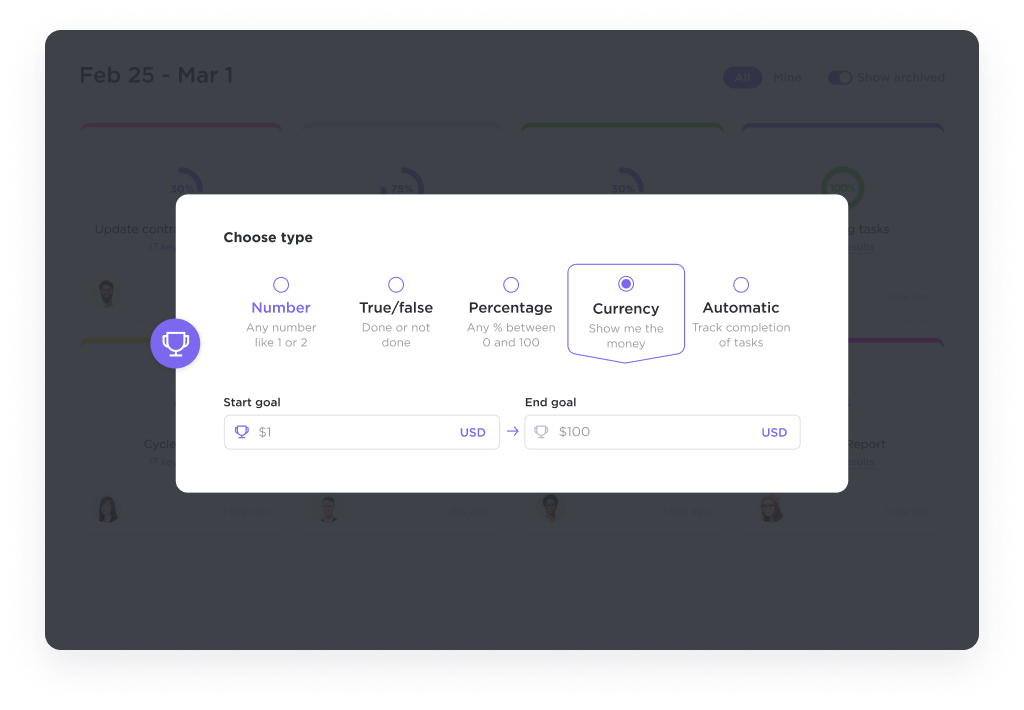
Start by creating your project goal and set measurable targets to achieve them.
For example, if your sales team’s Goal is to increase the average deal size. The measurable target for the salespeople would be:
As the salespeople progress, they can update targets in ClickUp.
The best part is that ClickUp’s project management software automatically calculates your project progress in real-time.
ClickUp’s SMART Goals Template organizes your goals into a manageable system that supports your daily goal-setting. This template breaks your goals into Specific, Measurable, Achievable, Relatable, and Time-bound (SMART) goals, visualizes the progress, and breaks down tasks into smaller, more attainable steps.
Once you understand a project’s expected outcomes, the next step is identifying its scope, deliverables, resources, and project tasks.
You can then get stakeholders’ inputs to ensure the scope is comprehensive and well-defined.
The best tip is to use ClickUp Docs to define your scope, goals, reminders, tasks, deliverables, resources, and more. The collaborative document editor within the project management software helps project managers standardize the project execution process.
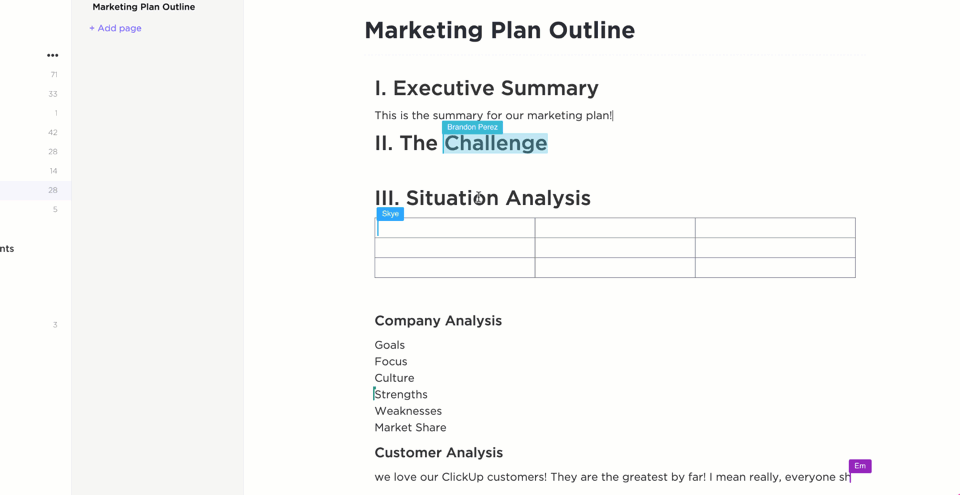
Here’s why project managers love ClickUp Docs:
Next, create a roadmap by plotting these goals and milestones against the project timeline so everyone can understand the overall direction.
You can visually represent a roadmap using ClickUp’s Gantt-Chart View within the project management tool.
This project management technique lets you view your project’s progress, tasks, and dependencies on a dynamic timeline. You can track deadlines and identify any bottlenecks that can delay your project.
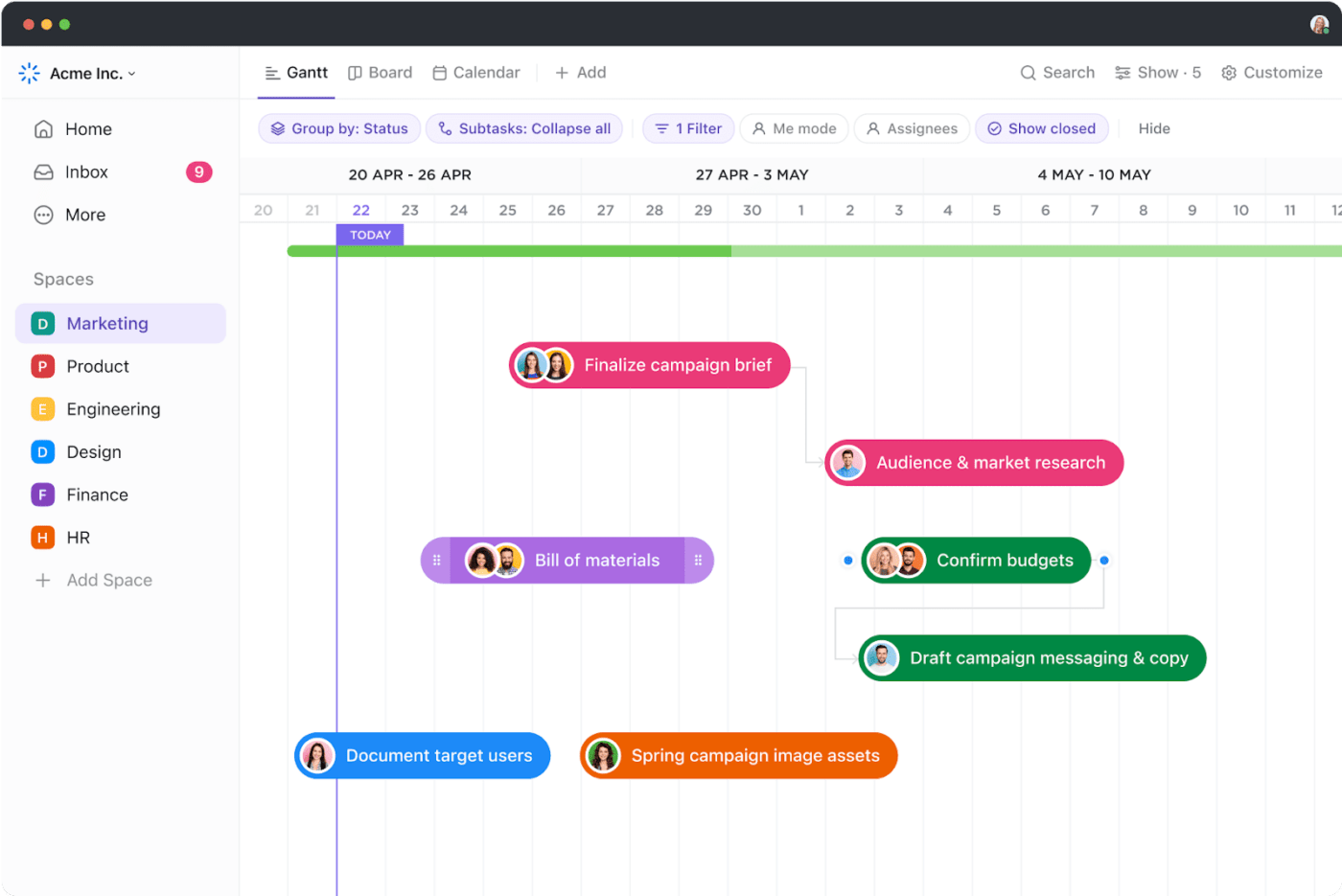
Define the various roles needed for your project and allocate resources for each task, such as design, research, development, and approval. When you’ve narrowed down who will do what, assign tasks to the identified team members.
ClickUp’s Workload View shows each team member’s work allocation to identify and assign resources accordingly for successful project completion.

Creating a visual representation of your project workflow helps all team members comprehend the roadmap and understand how their roles impact other tasks within the project.
Use ClickUp in two ways to represent your workflows: ClickUp Mindmap and ClickUp Whiteboard.
ClickUp’s Mind Map helps you create a step-by-step representation of your workflow by enabling you to create a task and then add related tasks and dependencies in a branching fashion in a single view. You can edit or delete tasks from the Mind Map and share them with your team members.
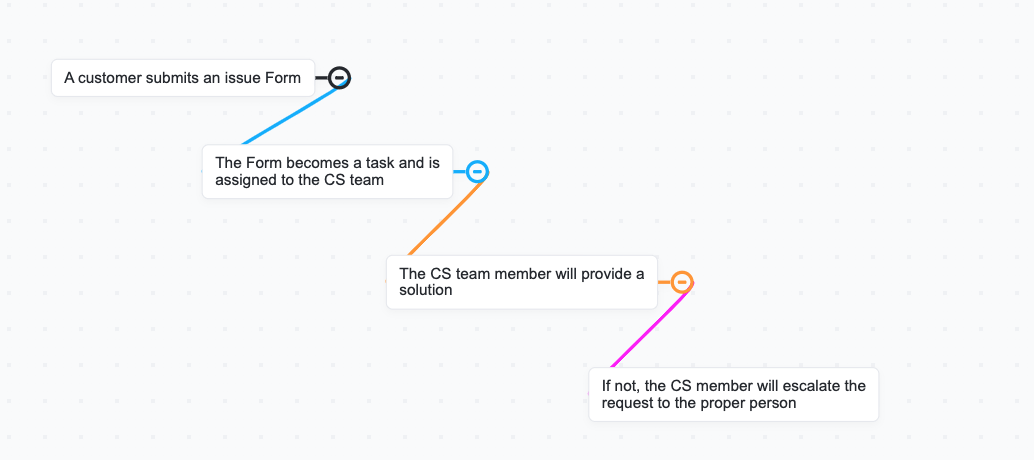
Alternatively, you can use ClickUp Whiteboard to present the workflow to your team. Link your ideas to tasks, files, and other vital information to add context.

| Pro tip 💡: ClickUp has several whiteboard templates to simplify even the most complex workflows. |
A flowchart in project management focuses on mapping project processes, including sub-tasks and decision points. It helps you understand the logical order of steps and identify areas where inefficiencies or delays might occur.
When there’s an issue, you can easily retrace the steps in a flowchart to identify the source of the problem and find solutions using ClickUp’s pre-built project management workflow templates.
Project managers use ClickUp’s Process Flow Chart Template to create a process map that’s easy to monitor, document all steps in the process, and troubleshoot problems early on.
Before project execution, test your workflow to identify any gaps or inefficiencies. Involve stakeholders and teammates working on the project with you to identify potential gaps.
Use their inputs to improve your workflow and launch it.
You must regularly review your project management workflow to ensure it’s working optimally.
An excellent way to do this is to track key performance indicators (KPIs) and metrics specific to your project management workflow. For instance, if you designed a customer service improvement workflow, tracking metrics such as first contact resolution, CSAT, ticket volume, and resolution rate can give you insights into its effectiveness.
ClickUp’s KPI Template allows managers and teams to track and visualize success metrics and align everyone around the objectives. Stakeholders get visibility into performance across the organization, while managers can analyze data and areas for improvement.
Here are some best practices for creating efficient and effective project management workflows.
Clear communication protocols are essential for effective workflow management. They define how frequently the team should give updates, which should be notified when an issue arises, and which escalation paths to follow.
You must also define the preferred communication channels or mediums.
For example, emails will be for formal communication regarding project updates, stakeholder communications, weekly progress reports, and official announcements.
On the other hand, instant messaging is excellent for quick collaboration. ClickUp Chat allows you to communicate with your teammates and share real-time updates. Simply tag a team member in the chat conversation, and they will be notified immediately.
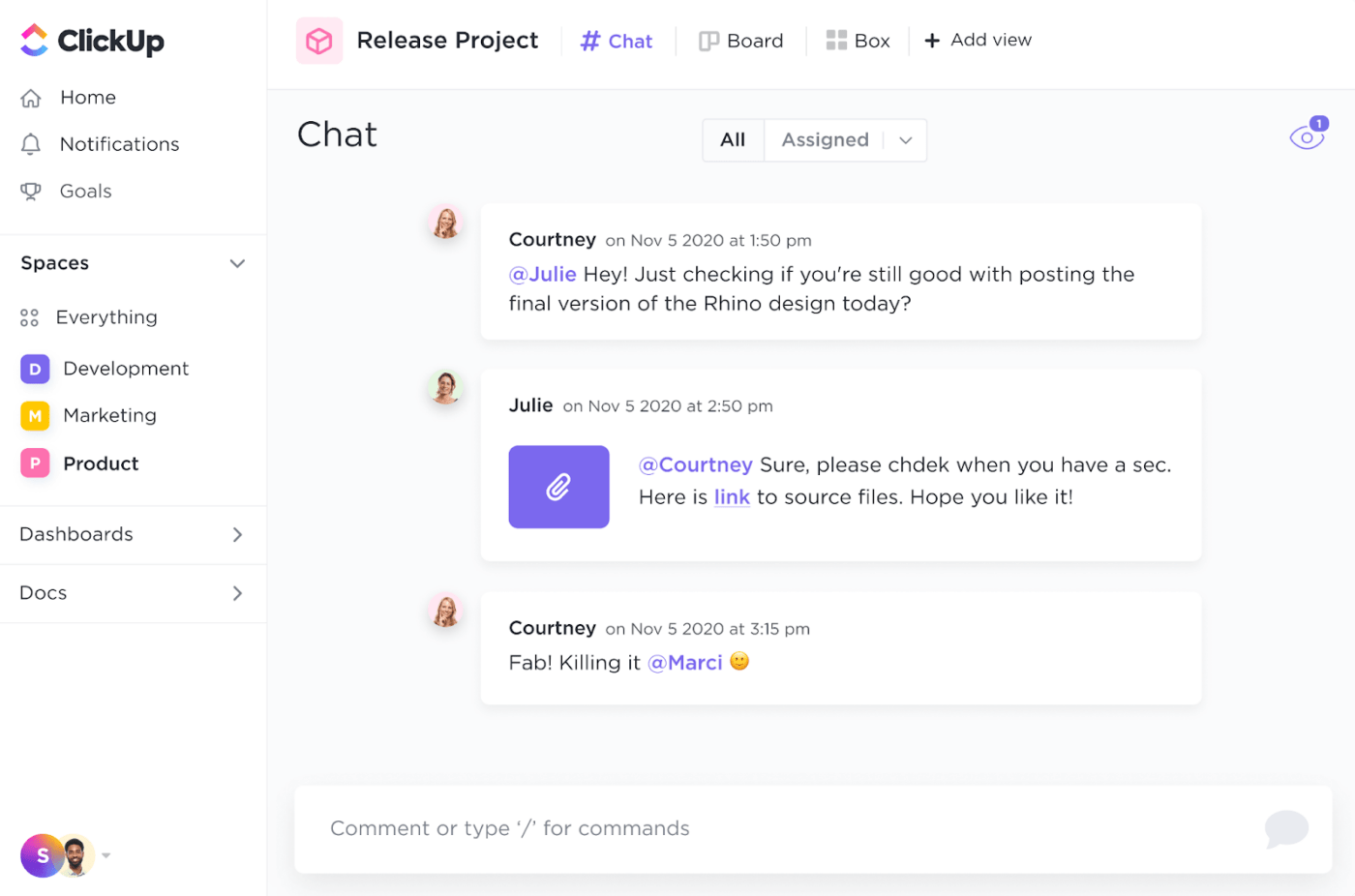
Be transparent about all the information, progress, challenges, and requirements in a project to foster trust among team members and ensure everyone is on the same page with priorities and expectations. This helps in decision-making and is essential for a seamless project management workflow.
Connect with your project teammates regularly to ensure an efficient project management workflow. Regular check-ins can help you identify where team members are stuck or facing challenges and take steps to resolve any issues.
Automate project management tasks such as reporting and insights with ClickUp Dashboards.
ClickUp Dashboards help project managers visualize project progress, deadlines, tasks, and assignees from a single control center. Get detailed reports on your project’s progress and identify any bottlenecks in your workflow.

Workflow management software can streamline your projects by creating customized flows and automating tasks.
For instance, ClickUp’s robust workflow management features help you manage tasks, design custom workflows, and compile detailed reports. ClickUp Automations automate workflows like setting a new due date when a status change occurs. You can even use the integration automation if your automation is related to other apps for data exchange.

Creating project management workflows is a fail-safe way to reduce chaos in even the most complex projects. Whether managing workflows for multiple projects or a single project, you need the right tools to track everything and ensure nothing falls through the cracks—output, deliverables, timelines, or budget.
Fortunately, ClickUp has all the features and templates you need to increase your odds of project success. ClickUp for Project Management is your centralized control center for collaboration, task management, resource management, and performance tracking. It reduces the manual work in setting up a project management workflow and helps you customize workflows according to your needs and priorities.
Sign up for free on ClickUp to build your project management workflows quickly.
A project management workflow is a well-structured, logical sequence of tasks, processes, and activities involved in project execution. The project management workflow process outlines the project’s scope, objectives, and goals and contains information on tools, budgets, and personnel required to complete a project.
While the stakeholders use the project management workflow to get an overview of the project’s progress and outcomes, project managers use it to identify bottlenecks or risks and take proactive measures to correct them.
The five steps of a project management workflow are:
Workflows improve project management efficiency by establishing a structured process for completing tasks and activities, allocating resources efficiently, reducing errors, and minimizing inefficiencies.
© 2026 ClickUp